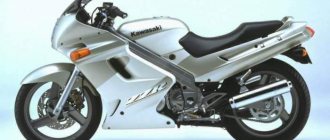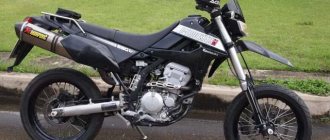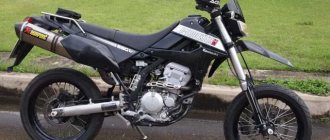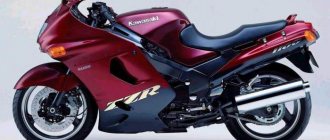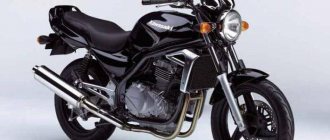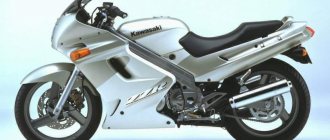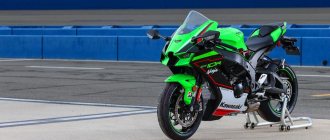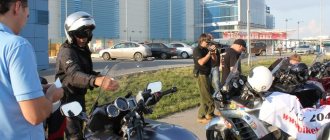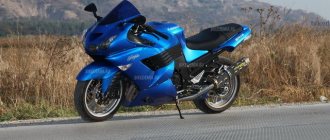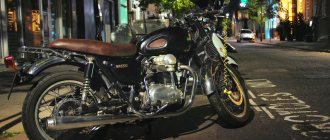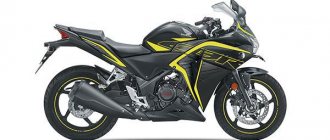- motorcycle model, Kawasaki brand
The Kawasaki 1400 GTR sports touring motorcycle model began its production at the end of 2007 (preceded by the Kawasaki GTR 1000 model) - model year 2008. The Kawasaki ZX-14 (ZZR1400) hyperbike platform was taken as the basis, combined with advanced technologies used in modern flagship sports tourers. On the US market, this model was called Kawasaki Concours 14.
The Kawasaki 1400 GTR features an inline 4-cylinder liquid-cooled engine that produces 160 hp. (with inertial supercharging) and 136 Nm of torque. The motor is tuned for traction in low and medium operating ranges, and has a variable timing system (from Mitsubishi Motors). Maximum engine performance is achieved at 6000-9000 rpm.
Another important feature of the motorcycle is the Tetra-Lever multi-link rear suspension, much like BMW (Paralever) and Moto Guzzi (CARC). When braking and driving over uneven surfaces, the rear of the motorcycle does not rise, but remains under load all the time, which has a positive effect on handling.
Among other things, the model is equipped with the KIPASS (Intelligent Proximity Activation Start System) system, which means access to starting the motorcycle without a key. The essence of the system is that the ignition key is always inserted into the lock, but it can only be turned if the owner of the motorcycle is standing nearby.
Other features of the Kawasaki 1400 GTR include a slipper clutch, electrically adjustable windshield, integrated saddlebags, tire pressure monitoring system, combined braking system (with ABS), aluminum frame, fully adjustable sports suspension, traction control (KTRC), heating steering handles and cardan drive.
Model history:
end of 2007 (model year - 2008) - official start of production and sales of the Kawasaki 1400 GTR model. Model: Kawasaki 1400 GTR (Europe, Asia, Oceania); Kawasaki Concours 14 (North America). Factory designation: ZG1400A8F, ZG1400B8F.
2009 - no significant changes. Model: Kawasaki 1400 GTR (Europe, Asia, Oceania); Kawasaki Concours 14 (North America). Factory designation: ZG1400A9F, ZG1400B9F.
2010 - The Kawasaki 1400 GTR motorcycle underwent a major update - engine traction control (KTRC), combined braking system (with ABS), new bodywork (which improved engine cooling), new mirrors (40 mm higher), adjustable windshield glass with a memory function, a fuel saving system (it controlled the ratio of gasoline and air at low revs and speeds) and heated grips. Top speed was limited to 247 km/h. Model: Kawasaki 1400 GTR (Europe, Asia, Oceania); Kawasaki Concours 14 (North America). Factory designation: ZG1400CAF, ZG1400DAF.
2011 - no significant changes. Model: Kawasaki 1400 GTR (Europe, Asia, Oceania); Kawasaki Concours 14 (North America). Factory designation: ZG1400CBF.
2012 - no significant changes. Model: Kawasaki 1400 GTR (Europe, Asia, Oceania); Kawasaki Concours 14 (North America). Factory designation: ZG1400CCF.
2013 - no significant changes. Model: Kawasaki 1400 GTR (Europe, Asia, Oceania); Kawasaki Concours 14 (North America). Factory designation: ZG1400CDF.
2014 - no significant changes. Model: Kawasaki 1400 GTR (Europe, Asia, Oceania); Kawasaki Concours 14 (North America). Factory designation: ZG1400CEF.
2015 - The motorcycle undergoes minor changes regarding gearbox ratios, upgraded steering (to improve stability at low speeds), increased rear suspension stiffness, added windshield opening adjustment, reprogramming of the ABS unit and a number of minor cosmetic changes - silver instrument bezels panels, extended heat shields on the exhaust pipes, changing the color of the warning lamp from red to yellow, changing the shape of the saddle, adding a new color Candy Lime Green, etc. Model: Kawasaki 1400 GTR (Europe, Asia, Oceania); Kawasaki Concours 14 (North America). Factory designation: ZG1400EEF.
2016 - The model is available in the following colors: Metallic Moondust Gray (all markets), Metallic Spark Black (North America) and Metallic Slate Blue (Europe). This year was the last for the Kawasaki 1400 GTR model in Europe - with the release of more stringent emission standards (Euro-4), the model cannot be sold in the EU. Model: Kawasaki 1400 GTR (Europe, Asia, Oceania); Kawasaki Concours 14 (North America). Factory designation: ZG1400EGF.
2017 - The North American version of the Concours 14 is released in a new color - Candy Imperial Blue. Model: Kawasaki Concours 14 (North America). Factory designation: ZG1400EHF.
2018 - no significant changes. Model: Kawasaki Concours 14 (North America). Factory designation: ZG1400EJF.
2019 - no significant changes. Model: Kawasaki Concours 14 (North America). Factory designation: ZG1400EKF.
2020 - no significant changes. Model: Kawasaki Concours 14 (North America). Factory designation: ZG1400ELF.
2021 - no significant changes. Model: Kawasaki Concours 14 (North America). Factory designation: ZG1400EMFNL.
Review of the Kawasaki 1400 GTR motorcycle
Firstly, the GTRA has a strong subframe, which cannot be said about the Figer. This is critical when you travel a lot and carry a large amount of cargo. Secondly, I was pleasantly surprised by the fuel consumption - despite the 1400 cc engine, on the highway I was quite comfortable with 5 liters. Another plus is the tank under the seat, so when the motorcycle is fully refueled, it behaves more adequately at low speeds and does not tend to fall over on its side. Due to the variable valve timing system, the response from a sharp opening of the gas is immediate (there is a delay on the fjr 1300). I was especially pleased with the brakes, which did not overheat and always provided adequate braking force.
I chose from: Yamaha FJR 1300, Honda Pan European 1300, Kawasaki GTR (Concours) 1400.
I didn’t consider BeMeVe due to the high cost of service, the cantilever mounting of the rear wheel, and the large number of negative reviews about the reliability of the gearbox. Especially on the K 1200 GT versions from 2004-2006.
Honda gradually dropped out of the list because... the options in my budget were no younger than 2005-2006, and with decent mileage, well, in design it is still more purely touristic, and with the panniers removed it looks a bit strange.
Well, in the battle between Yamaha and Kava, GTR won, for the following reasons:
1. Power (Kava - 160 hp, Yamaha - 140 hp. There is never too much power and torque - especially on the highway, when overtaking)
2. Suspension (Kava: front - upside-down, rear - four-link Tetra-Lever system, smoothing the reactive moment of the cardan during active acceleration. Yamaha - telescope front, mono - rear)
3. Kava has more stock panniers
4. Kava has a 6-speed gearbox (Yamaha has a 5-speed gearbox)
5. Kava has an intelligent remote control and engine start system KI-PASS (Kawasaki's Intelligent Proximity Activation Start System). (No need to rummage through your pockets and take out the keys. There is an electronic tag in your pocket, go up to the engine, press the starter button, start it, and go - convenient!)
6. According to reviews, the Yamaha has a high center of gravity, which is why it becomes a roll at low speeds.
7. Pressure sensors in the wheels, which allows you to control the pressure in the tires while driving.
8. Well, in terms of design, I’m more intrigued by the GTR, and the bike itself is quite rare, because we all want to have a vehicle “not like everyone else,” but the FJR is already quite popular and widespread. + this is still Kawasaki - I won’t change my favorite company!!! :)))
So in America I picked up a wonderful version of the Kawasaki Concours 1400 ABS, 2008, with a mileage of 17,000 km, in perfect condition. One owner who drove it mainly in the sunny state of Florida, where he lives. In 2 weeks the motorbike will sail to Novorossiysk, then delivery by a transport company, and that’s it, I’m on a new horse!!!
With the budget for which I bought a motorbike with such mileage and condition, here in Russia I simply won’t find any options! So, now I’ll take my darling on long trips! Hooray!!!:))
There are many articles on the Internet on this topic, but they are based on short-term tests or ordered by motorcycle magazines for PR of a certain brand. I want to tell you my opinion about the GTR 1400 and FJR1300, based on the experience of long-term operation of these sports and touring motorcycles for their intended purpose.
My experience in motorcycle tourism is a modest 8 years. The first 6 motorcycles were exclusively Yamahas. I chose sports tourists. At that time, the best in class was the Yamaha FJR 1300A. I had two of them, on the first I drove 60,000 km and on the second 40,000 km. There were Europe, the south of Russia and neighboring countries.
In 2010, I decided to change Yamaha and bought a Kawasaki GTR 1400. Many of my friends who were riding an FJR 1300 at that time dissuaded me from this idea. But the choice was made, I decided to take a risk.
I chose a difficult test for the new motorcycle - a trip from Yekaterinburg to Africa through all of Europe. The total mileage was about 20,000 km.
What advantages over the FJR did I notice during long-distance driving on the GTR 1400?
Firstly, I was surprised by the pleasant gas consumption, after the FJR, in 6th gear at a speed of 130 km per hour - consumption is less than 5 liters. The lack of a direct overdrive transmission on the FJR is one of the main disadvantages of this model, since on a long-distance journey of 10-15 thousand kilometers it is VERY noticeable. Especially with the cost of gasoline in Europe. And our gasoline prices have exceeded all permissible standards.
Another drawback of the FJR1300 is the weak rear subframe; on Russian roads it cannot withstand the load and bursts, which is what happened to me on the way to Crimea. This was not noticed on the GTR, despite the fact that I was driving with a passenger and a fully loaded rear case.
Another disadvantage of the fjr is that the gas tank is at the top, and when fully refueled, these 20 kg at the slightest inclination tend to put you on your side when driving at low speed or starting off on an incline. And in the GTR, the gas tank goes under the seat, which has a positive effect on the center of gravity and weight distribution of the motorcycle.
As for the characteristics of the engines, they are, in general, similar. Despite the fact that the GTR has 10 horses more. It would be better to make 149 horses, so as not to pay excise duty to customs when buying a motorcycle outside of Russia. This is what creates the price difference between the GTR and FJR (50,000 rubles).
It is worth noting that, unlike the FJR, there is no second delay from idle to medium speed; the engine responds instantly, due to adjustable valve timing, which optimizes power delivery.
The side cases of the GTR are more aerodynamic, and at high speeds of 160-200 km per hour, the rear of the motorcycle does not wobble. In the GTR, I easily accelerated along the autobahn in Germany at 270 km per hour and it moved like a locomotive. And with the FJR, on the same autobahn, after 220, the rear of the motorcycle began to walk along the road.
Unlike the FJR 1300, in the GTR, when starting and braking, the rear of the motorcycle does not rise due to the Tetra-Lever suspension, but remains under load, which has a positive effect on controlling the trajectory of the motorcycle.
The GTR's inverted fork gives better cornering control.
The GTR's ventilated petal-type brake discs heat up less, which has been tested on mountain serpentines in Europe.
It is also important to note such a nice option on the GTR as a key fob with the KIPASS system. This means you don't have to constantly take the key out of your pocket and insert it into the ignition. He always stands there. But you can turn it only when the owner of the motorcycle is nearby.
Thus, the GTR 1400 showed undeniable advantages over the FJR1300 in its efficiency, comfort and reliability.
After several long long distance rides, I again came to the conclusion that in terms of price/quality there is no motorcycle better for me than the GTR1400. Therefore, my new motorcycle is again a GTR 1400 2011, which did not let me down on a trip to Baikal in 2012.
The choice is obvious; all my friends, after looking at my operating experience, switched to the Kawasaki GTR1400.
P.S. Yamaha upset again. 2013 model without 6th overdrive.
Greetings. I decided to unsubscribe, having ridden 10,000 on a 2008 Kawasaki GTR 1400. I rode a blackbird for 5 years and now I wanted to go to Europe on a motorcycle. The choice fell on the GTR.
So I drove 7000 km. across Europe: Belorasha-Poland-Germany-Czech Republic-Austria-Italy (Rimini). After 300 km. I'm starting to get tired 5th point, but I can go. You go 1000 km/day normally.
Up to 4500 rpm. seems sluggish. Then it goes off like a locomotive. The landing after the blackbird seems very comfortable, the front and rear suspension adjustments allow you to make the suspension both on a cross-country bike and on a sport E. He is taller than a thrush. It steers very well in corners, lighter than a blackbird.
Wind protection, taking into account the high glass, is at the highest level. 140-160 - cruising. Driving slower was no use. He loves high revs. If you feel sick (100 km/h), it starts to consume more fuel over time. apparently dirtying the candles.
crash in Italy on pebbles at 60 km/h while overtaking. The defense is working. Slight fright. It breaks the mirror and the right footrest mount. tore up the right side and chest. But you can use plastic in place. It’s hard to find argon in Venice... The road home.
Upon arrival, I removed the second mirror and chests. I twist the pendant. Here's a sport for you, only with a comfortable fit. Still, sport tourism is my motorcycle class. But if it's GAD. Happy with everything. But it is necessary to install customized mirrors for the city. narrow. because standard ears make the bike 1.2 meters wide, so you can’t trot in traffic jams. So I’m even glad about the fall, which opened up the sporting possibilities of GAD for me.
Kozlit is quite easy, but on the first one the speed is about 60 km. those. goes after 4500 rpm.
Bottom line: advantages: power - comfortable fit - gimbal - computer - maneuverable - wind protection
Disadvantages: insufficient ability to reach 4500 (thrush is at its best in this regard), the seat is more sporty than touring, there is no traction and ABS (available since 2012). Traction could have saved me from falling. ABS is also important for a motorcycle of this weight (300 kg - dry).
Good luck to everyone on the roads!
Specifications:
| Model | Kawasaki 1400 GTR |
| Motorcycle type | Tourist |
| Year of issue | 2008-present vr. |
| engine's type | 4-cylinder, 4-stroke |
| Working volume | 1352 cc cm. |
| Cooling | Liquid |
| Bore/Stroke | 84.0 x 61.0 mm |
| Number of valves per cylinder | DOHC, 4 valves per cylinder, variable timing |
| Compression ratio | 10,7:1 |
| Fuel supply system | Injector, ø40 mm x 4 |
| Ignition type | digital |
| Maximum power | 117.6 kW (160 hp) / 8,800 rpm (with inertial charging) 114 kW (155 hp) / 8,800 rpm (without inertial charging) |
| Maximum torque | 136 N•m (13.9 kgf/m) / 6200 rpm |
| Transmission | 6-speed, reverse |
| type of drive | cardan |
| Frame | Monocoque frame, aluminum |
| Front suspension | 43 mm inverted fork (adjustable preload and rebound), 113 mm travel |
| Rear suspension | pendulum with monoshock absorber (Uni-trak, Tetra-lever), reg. preload and rebound, stroke - 136 mm |
| Front tire size | 120/70ZR17M/C (58W) |
| Rear tire size | 190/50ZR17M/C (73W) |
| Front brakes | 2 discs, 310 mm, 4-piston radial calipers (ABS) |
| Rear brakes | 1 disc, 270 mm, 2-piston caliper (ABS) |
| Overall dimensions (LxWxH) | 2270x1000x1290 mm |
| Seat height | 815 mm |
| Wheelbase | 1520 mm |
| Gas tank capacity | 22 l |
| Motorcycle weight (curb) | 304-313 kg (depending on the year of manufacture) |
Driving performance,
Initially, the maximum speed of the motorcycle was specified as 300 km/h . However, during the first restyling - in 2010, a jammer is installed, which cuts the speed at around 247 km/h . The same figure appears in the instructions.
Sports bikes will also envy the acceleration - from 0 to 100 km/h in 2.77 seconds , to 200 km/h - 8 seconds . Measurements were made using GPS.
Fuel consumption
Consumption declared by the manufacturer is 6.5 liters per 100 km . Users note that there are no more than 5 on the highway.
Features of the GTR 1400
The bike has many distinctive features.
- Changed timing phases , which gives improved traction from the very bottom.
- The supercharging system allows you to develop power up to 160 mares .
- Keyless start - there is still a key in the ignition, but you can’t turn it without a special card issued to the owner.
- Lever suspension at the rear allows the bike not to bounce on bumps, but to remain in contact with the track no matter what the owner does. ( you can't do stoppie).
Thanks to its sporting roots, the GTR 1400 is equally well suited for fast driving on straight roads as well as for long climbs along serpentine mountain roads. Its chassis is not designed only for complete off-road use.
The differences also include the fact that the manufacturer purchases many components of the bike from competitors who are more experienced in certain aspects.
There are also purely tourist gadgets:
- heated handles;
- windshield height adjustment (both manually and electrically)
- tire pressure monitoring;
- large fuel tank ( 22 l );
- good weight distribution;
- low center of gravity.
But they also note good handling and excellent brakes .
Modifications and competitors
The motorcycle's competitors include the Yamaha FJR 1300 . The manufacturers themselves also call the Honda ST 1300 Pan European (discontinued in 2021) a worthy opponent.
Being itself a modification, the bike has no derivatives. But the user has a choice between two versions.
Kawasaki 1400 GTR and Kawasaki 1400 GTR Grand Tourer . The filling and cosmetics are the same. The second has side and central suitcases of better quality, holders for the navigator, a socket, and improved protection from scratches and chips.
The standard cases are quite roomy - a full-size helmet can easily fit in and there is room for small things. If desired, you can install a large medium trunk.
